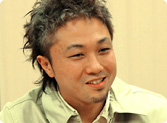2. A Question of Realism
Wii Sports and the Mii Channel fit together very well, don't they? So much so that one would never guess that they had been developed separately.
That's true. By being able to use a Mii that has been made in the Mii Channel as an in-game character, I feel these five sports games have come together very nicely. It even feels as if we designed Wii Sports this way so that everyone could appreciate how great the Mii concept is.
Before the Mii Channel and Mii characters were incorporated into the internal system functions, there were a lot of lengthy discussions about what to do about the characters in Wii Sports, weren't there?
Yes. First of all, one of the most important concepts for Wii is making something that everyone in the family can relate to. We thought the best way to do that was by having something in the game that represented the player or other people in their family. Of course, the best way to do that is by having characters that resemble those people.
At the beginning, you even seriously considered having users take pictures with their digital cameras, putting that data on Wii via an SD card, and then pasting the pictures on the faces of their in-game characters.
But we realised that hardly anyone would actually do this unless they were really familiar with what to do. So no matter how much you wanted to get someone in your family involved in a game, there would be no way to do it unless someone else set it up for them first. We then realised that even the act of making a character to represent yourself would have to be something that people would want to try out for themselves. It was around that time that we heard about the kokeshi3 idea from (Shigeru) Miyamoto-san. 3Kokeshi are traditional wooden Japanese dolls. They are cylindrically-shaped, with no arms or legs.
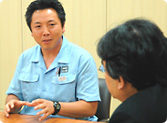
You mean the idea of putting a kokeshi version of yourself in a number of games, right?
Right. Miyamoto-san had been talking about it for ages. And separately from that, there was a very simple prototype in which kokeshi-like characters were already implemented. Ota-san and many others who played this prototype said that they really felt "That's me!" when they played it.
At the prototype stage, the characters that were used were very plain, simple models. This was mostly because our group didn’t have a designer!
Ah, I see. Because there were only programmers in your group, you didn’t have a designer! (laughs)
That's right. When we tried playing with these very simple characters, we really felt that we were the ones in the game. We tried using Mario as a character once, but then it didn't feel like we were the ones playing anymore. It felt like Mario was actually the one playing and we were just controlling him. But it wasn't the same when we used these simple models. Rather than feeling that the kokeshi model was playing, it actually felt like we were the ones in the game. But with such simple models, it felt like something was missing. Around this time, the caricature software for the DS was created.
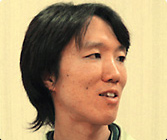
We also talked about this in our discussion of the Mii Channel, but it was when I came across this software and showed it to Miyamoto-san that things really took off, wasn't it?
Yes, although at first we were not talking about making the Mii Channel a core system function. We were only thinking about using this software to make the characters in Wii Sports. But the more we talked about it, the more we realised that rather than incorporating this software in a specific game, it would be better if there were a place on Wii where these characters could be made. Before we knew it, we were planning the Mii Channel.
We also had some good fortune here, didn't we? In a discussion of the course that led to the Mii concept, we can't forget about Mario Artist: Talent Studio, which Yamashita-san worked on a long time ago. Could you explain to us what kind of game that was?
Sure. Talent Studio was a piece of software that was developed for the 64DD, a hardware attachment for the Nintendo 64. There was a series of software for the 64DD called Mario Artist, in which the player could make their own creations. To be a little more specific, there were three games in the series. Paint Studio allowed the player to draw pictures, Polygon Studio let the player create 3D models, and Talent Studio allowed the player to create their own characters. I worked on the Talent Studio project, and... well... let me just say that it was very tough!
(laughter)
At that time, there was already a way to incorporate actual photos. Of course, SD cards weren't around yet, so the process wasn't that simple. The player had to use the Game Boy Camera to take pictures and then connect an accessory called the Capture Cassette to the 64DD. Just coming up with a way to let players do this was a lot of work, but what caused us the most trouble was finding ways to make use of the characters that the user had gone to all the trouble of making. We tried various ideas such as using the characters in mini-games, and... what do you call the type of game where the character has to move around on top of a ball?
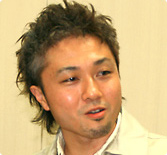
I believe it's called "tamanori"4. 4Tamanori means to balance oneself on top of a ball in Japanese.
Right, tamanori! We tried using the character in a tamanori mini-game and so on. We ended up making a movie mode where the player's characters could be used. In the end we weren't able to successfully use the character in an actual game. Looking back at it now, I was still new at the company, and honestly speaking it was a tough time for me. Of course, I had fun with parts of it too, but... Well, to cut a long story short, when I first heard about doing personalised characters for Wii, I thought "Oh no!"
(laughter)
At first I felt anxious about it, but as I heard more about how it would fit in with the Wii concept, I came to realise that it was a good idea. With Talent Studio ten years ago, we didn't have the concept of bringing the family together.
Well, ten years ago, you started development with the simple idea that it would be fun to create a person that would appear in a game.
Right. In those days, we were just happy that we could make and manipulate a 3D image. I feel that over the last ten years the idea has been pared down to its essentials, leaving Wii to inherit only the most important parts.
Were you able to apply any of the lessons you learned from Talent Studio to development this time around?
I think so. One thing that didn't satisfy me about Talent Studio was the fact that we overdid the number of effects. I mean, when you decide to make caricatures, you want to try out a ton of different ideas. You want to try making realistic depictions, as well as trying to make them in the style of a manga5 or American comic book. Ten years ago, the design of the end result was disorderly and fractured, so with Wii Sports I kept telling everyone that all of the effects had to be neatly arranged. Around that time, someone showed me the DS caricature software and I thought "This is it! It's already done!" 5Manga is the Japanese word for Japanese-style comic books.
(laughter)
It was already possible to use the characters you created in the DS, so it was very convincing, wasn't it?
Definitely.
At that time the DS software was already up and running, and everyone who saw it said: "That's what we've been looking for!" If it wasn't for that, it wouldn't have all come together so quickly.
Well, Miyamoto-san had been talking about the kokeshi idea for a long time, but we never really reached any conclusions about it. We weren't sure how or to what extent we should allow users to make their own characters. Speaking of which, after Talent Studio came Manebito! (laughs)
Ahh, Manebito was the same kind of software, wasn't it? Shimamura-san, could you explain a bit about it to us?
Ahhh, I didn't think the topic of Manebito would come up - after all, it was a game that never saw the light of day! Well, Manebito was a game for the GameCube that came about in the same way as Talent Studio. It was even shown at exhibitions with the name Stage Debut. It was also a game that allowed you to design characters to look like yourself, but it put more emphasis on the ability to customise the characters. There were hundreds of outfits and accessories to choose from, allowing the user to create characters with an incredible amount of detail. In the end it was never released... The big problem was... well... what to do with the characters once you'd made them!
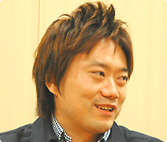
(laughter)
Once you had created a character that looked like yourself, well, that was it. When we asked people what they thought about it, they always asked "What are we supposed to do next?"
You ran into the same wall that they did with Talent Studio, didn't you? (laughs)
We did. So when I heard that caricatures were going to be used in Wii Sports, I also thought "Oh no!"
(laughter)
In other words, even though there are a lot of possibilities for playing with personalised characters, you couldn’t narrow it down enough. So time just kept on going by while you were looking for an answer.
That's right. We knew that even if there were a ton of mini-games, people would soon get tired of playing them, and in the end the characters they made wouldn't be used anymore. This problem was solved with Wii Sports by giving the characters a proper place, so to speak. In this game, you can have the experience of being a professional tennis player via your on-screen alter ego. I never realised how much fun it could be to feel like you're really in a proper game, as opposed to just in a mini-game that doesn't have any depth. Simply put, the level of emotional involvement in the game is completely different.
Even with the plain kokeshi characters, you really feel like it's you in there. I know I've already asked you all this before, but the kokeshi are very far from being realistic. Didn’t you feel some uncertainty, that they were just too simple?
Did anyone ever say they should look realistic? No one did, right?
I actually wanted to go ahead with just the plain kokeshi. During development when we tried it out with Mario, I was pretty nervous. I wouldn't have known what to do if the kokeshi were replaced! (laughs)
The kokeshi might be simple, but your mind helps make it more real. In Wii Sports Baseball, even though the arms and legs aren't shown when the fielders move, it feels realistic when you see them in motion.
Also, I think to some extent it's precisely because the characters are simple that they fit so well with the concept of creating personalised characters. Since the models are super deformed6, you just move the eyes and eyebrows apart a little bit and you've got Yamashita-san! (laughs) 6Super deformed is a technical term for the Japanese style of caricature, common in manga, where characters have unrealistic or exaggerated features, such as small bodies and oversized heads for example.
I think it's great fun to see characters that resemble people you know playing tennis or baseball like pros.
People usually end up making people they know, don't they? In the end, I think that's the most fun.
Speaking of which, the other day we got a family to come in to play Wii Sports so we could hear their impressions. We made Mii characters of everyone in the family in advance, and they were all really happy with it. When the grandmother made a nice catch in baseball, everyone was so excited! They were all saying "Way to go, Grandma!" Beforehand, I had wondered if something like that would happen. Needless to say, their reactions exceeded my expectations.
